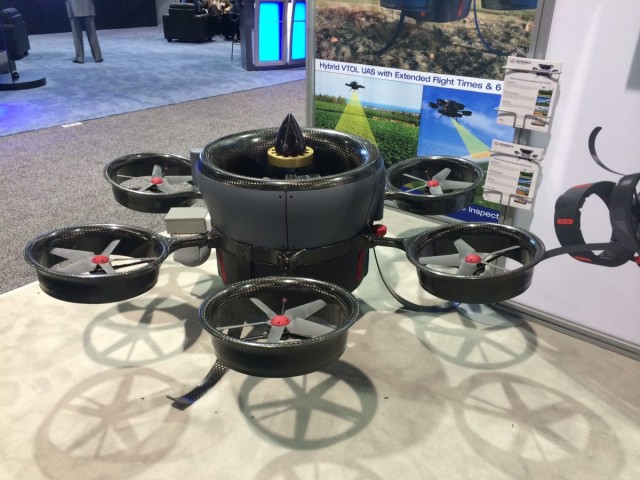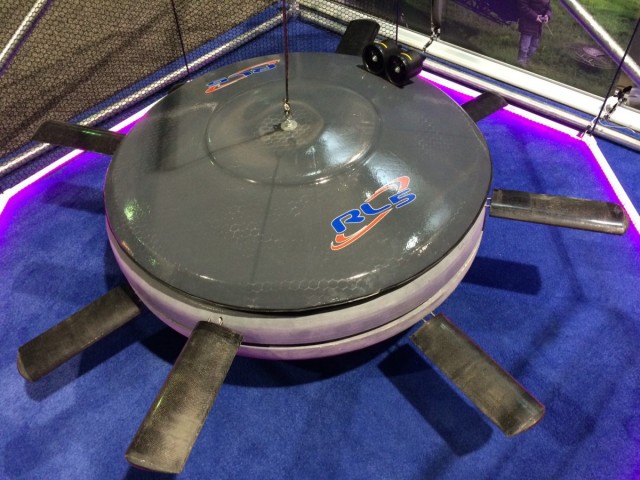Here’s a look at some of the most interesting, innovative and outlandish drones at the recent Unmanned Systems 2015 show in Atlanta, Georgia, hosted by the Association for Unmanned Vehicle Systems International.
The SnowGoose BRAVO from Canada-based Mist Mobility Integrated Systems Technology, or MMIST, is an update to the company’s SnowGoose CQ-10A cargo drone.
The original played a role in U.S. Special Operations Command missions for years. The Bravo may look like a helicopter with that big rotor up top, but notice the large back propellor? The SnowGoose is an autogyro, an aircraft whose rotor serves as a stabilizer while motive power is delivered to the propellor. Unlike a helicopter the main rotor of the BRAVO does not need mechanical power once the drone is flying. Before takeoff, shaft power is applied to the main rotor to get it spinning then the system hops into the air like a helicopter. The pusher propeller gets it moving forward to maintain rotor flying speed. MMISTpresident and SnowGoose creator Sean McCann said the SnowGoose BRAVO can carry 600 pounds of cargo, reach 18,000 feet, and accelerate past 70 mph. And it uses less energy than would a conventional helicopter design, he said.
 Then there was Reference Technologies with the Hummingbird II octocopter, which can go to 14,000 feet and travel 60 mph. It’s meant for surveillance.
Then there was Reference Technologies with the Hummingbird II octocopter, which can go to 14,000 feet and travel 60 mph. It’s meant for surveillance.
The Eturnas D, a semi-solar-powered drone from DII, has a seven-foot wingspan and weighs just 10 pounds. Solar-powered drones aren’t new, but integrating them into new frames is an ever-evolving art. The Eturnas can fly for six hours at 27 mph or 1.2 hours at 45 mph.
Part unmanned Osprey, part Transformer, the Lotus from Joby Aviation was developed in concert with NASA. Its wingtips transform into propellers to provide vertical lift like a helicopter. Once aloft, the tips fold back and the tilting tail rotor takes over to reduce drag and allow cruising. “A future 275 lb.-class hybrid-electric UAV development of this configuration has the potential to become the first VTOL aircraft to achieve 24 hour endurance,” the website says, hopefully. Check out the technical paper and animation of the propeller action:
The flying disc-shaped Radeus from Radeus Labs features two sets of counter-rotating blades. During vertical lift, the blades spin at 60 mph, pulling the saucer off the ground. But when the drone moves forward in the air, the top portion of the vehicle converts to an autogyro.
Its maker, Ray Hayden, says that he’s achieved the vertical lift portion on a similar model but not this one. He came to Atlanta seeking partners and investors.
Looking like a cross between the IT-O interrogator droid from Star Wars and a disco ball from hell, the All-Terrain Land and Air Sphere, or ATLAS, from Unmanned Cowboys is a rotorcraft with a spherical “exoskeleton.” The frame protects it when it crashes and enables the operator to adjust it and put it back into flight without touching it. (See video below). It’s ideal for those situations when you may want to throw a drone into a room to collect intelligence but don’t want to go in and pick it up when you slam into the doorframe.
Source: Defense One






